Tree insects are all too common throughout Canada. TreeCanada lists insects as the #1 tree killer in Canada, followed by disease and invasive plants. Natural Resources Canada lists over 300 distinct species of tree insects found in Canadian forests. You’d have to be a trained entomologist to be able to identify them all–and that’s assuming you’re even able to identify their existence in the first place.
That’s exactly what we’re going to show you. Here are some signs that your tree might be experiencing a tree insect infestation.
Some tree insects are so subtle you might not be able to notice signs of an infestation right away. At first, it may seem like your tree has come down with some disease. That’s not altogether wrong, as a tree insect is basically another form of malign malady.
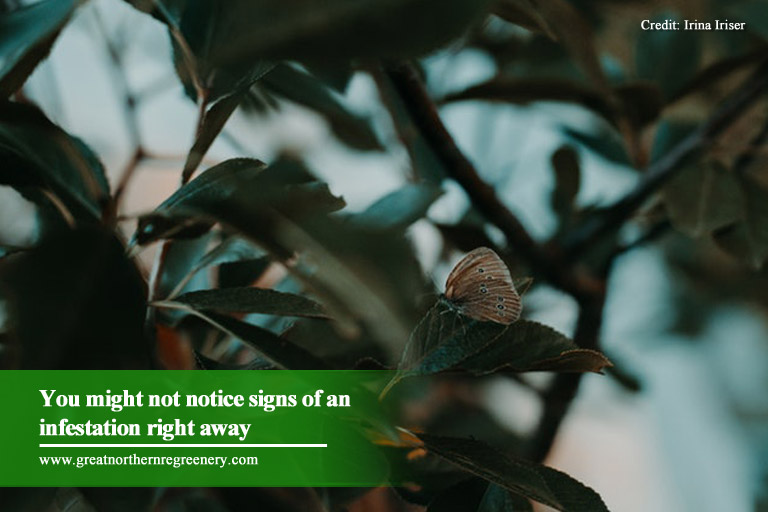
There are numerous different classes of tree insects, as well, and each one leaves a tell-tale trace of its presence. Here are some of the most common types of tree insect infestation.
Boring Insects
Boring insects can be some of the most dangerous and destructive tree insects, often having lethal consequences for the tree or shrubbery that they call home.
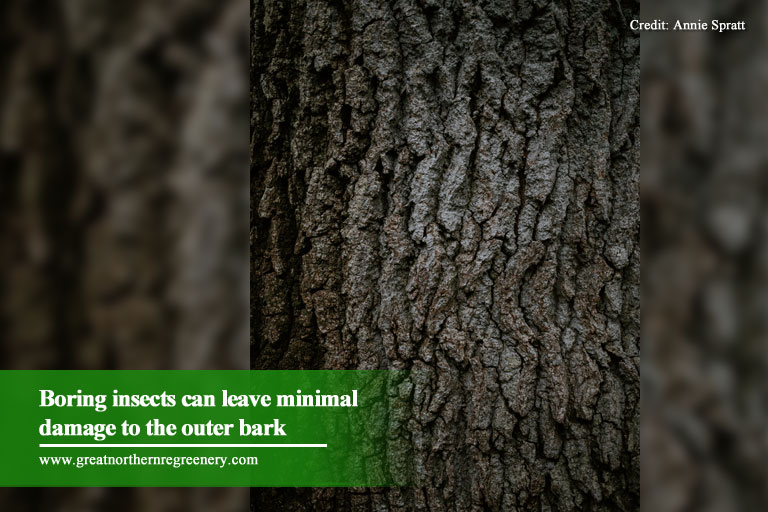
Boring insects feed off of the tender inner bark. This means that external signs of an infestation may be subtle, as the damage to the outer bark can be minimal. This makes boring insects even more of a problem, however, as they can have disastrous results as they gradually erode a tree’s ability to transport water and nutrients.
To identify a boring insect infestation, keep an eye out for small exit holes in the bark or branches. Also, watch for sawdust or frass near the base of a tree. Dead leaves are also another sign you may have an infestation of boring insects.
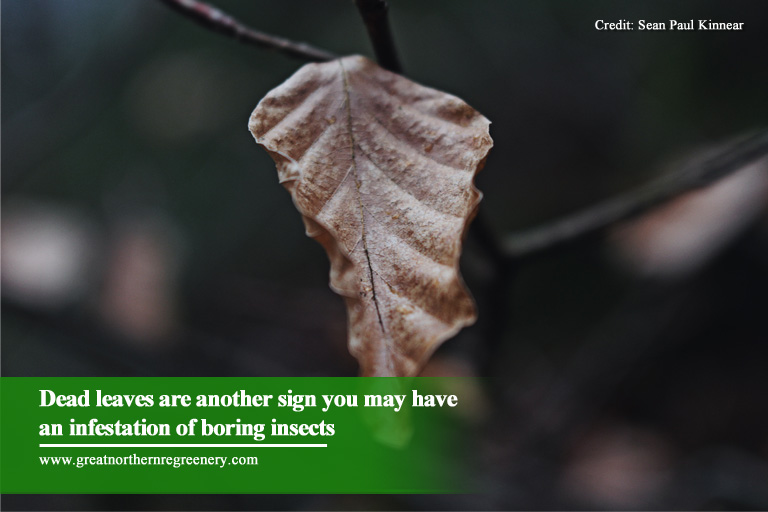
Some of the most common types of boring insects include:
- Emerald ash borer
- Ambrosia beetle
- Asian longhorned beetle
- Bronze birch borer
- Two-lined chestnut borer
- Bark beetles and weevils
Chewing Insects
Chewing insects are more noticeable as they leave visible traces of their presence. Leaves full of holes are the most common sign that you’ve got an infestation of chewing insects.
While chewing insects are some of the easiest to spot, they also have some of the most disastrous consequences for your trees. They leave your trees looking withered and diseased instead of healthy and robust. The risks are not entirely cosmetic, as well. Chewing insects greatly reduce a tree’s growth and ability to thrive, especially if left untreated for a few years.
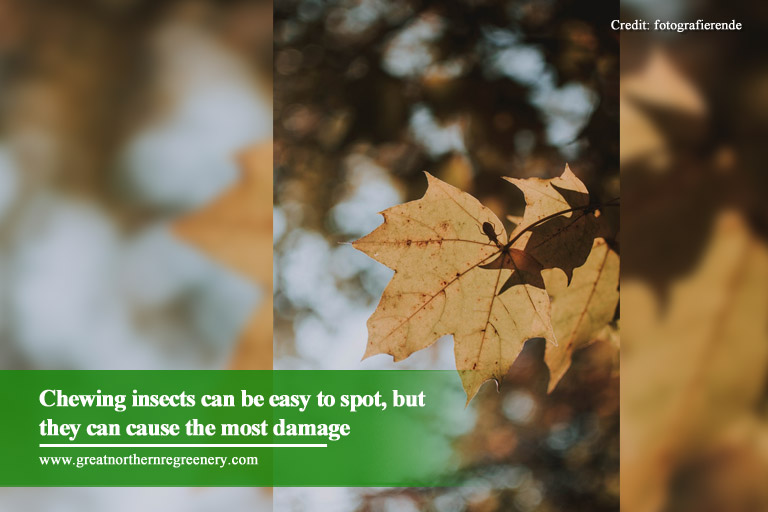
If you suspect you may have an infestation of chewing insects, begin by looking for nests or the actual insects, as they feed on a tree’s exterior. Skeletonized leaves or the complete removal of leaf tissue are also signs chewing insects are making their home in your trees. A large amount of lost leaves is also another telling sign of a chewing insect infestation.
Some common types of chewing insects include:
- Winter moth
- Gypsy moth
- Tent caterpillars
- Oak processionary moth
- Webworms
- Oakworm
- Cankerworm
- Leaf beetles and leaf miners
Sucking Insects
The third most common category of tree insects are sucking insects. Sucking insects feed themselves with miniscule, needle-like mouths. Sucking insects tend to be nearly microscopic, so you may not detect their presence for some time. This can result in a lethally large population of sucking insects before you even notice their existence.
To identify the presence of sucking insects, keep an eye out for withered leaves. Loss of needles and premature falling of leaves are other good signs that you may be experiencing a sucking insect infestation.
Sucking insects can expose your trees or woody ornamentals to disease, as well. A coating of sooty mould on a tree’s leaves is another sign you may have an infestation on your hands.
Some common types of sucking insects include:
- Mites
- Scales
- Aphids
- Whiteflies
- Psyllids
- Adelgids
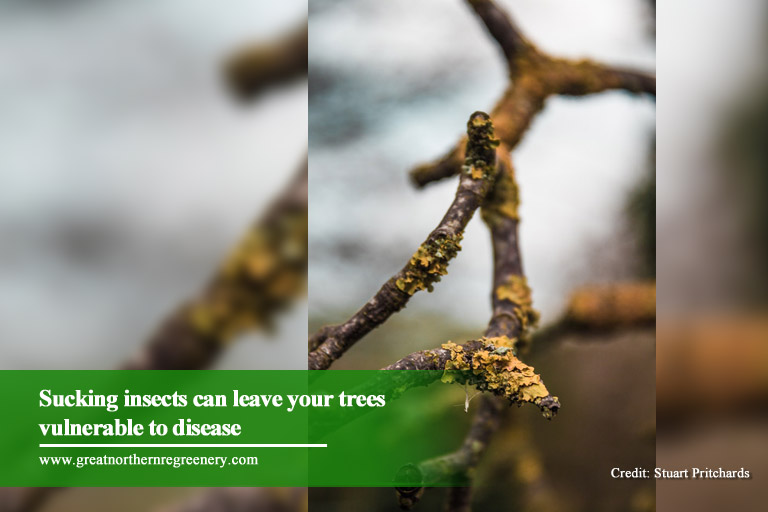
If you feel like you may have an infestation of sucking insects, you might want to contact a tree service in Aurora to have them come out and take a look. These infestations tend to spread, and they can take out your entire arbour if you’re not careful.
You don’t necessarily need to know an insect species to recognize there’s a problem. You can sometimes reverse-engineer a tree’s symptoms to figure out what kind of tree insect you’re dealing with.
Here are some other signs you may be experiencing a tree insect infestation.
- Dull Leaves and Foliage
We’ve already talked about how sucking insects can make your tree look like it’s having the life sucked out of it. Dull, lifeless leaves and foliage are often a sign that a tree insect may be feeding on your trees.
Begin by looking for pale discoloration. This can be a sign of an infestation, most likely by a sucking insect. It’s also a sign that it may be early on in the outbreak. Leaves and foliage begin to curl and distort as an infestation progresses and gets more intense.
- White Spots on Leaves
White spots on leaves and branches are another sign that you may have an infestation of either boring or sucking insects. The white spots that you see are often, in fact, thousands of tiny insects that are feeding on your trees’ sap and other internal fluids.
It’s not uncommon for a tree owner to mistakenly identify these white spots as a mould infestation. If you’re not sure if the white spots you’re seeing are a form of insect or a mould infestation, you might want to consult a tree service in Bradford.
These are just a few of the signs that you may be experiencing a tree insect infestation. As we’ve stated, there are over 300 different species of insects that make Canadian trees their home and food source.
If you’re not sure whether your trees are infested or not, it’s a good idea to contact a tree service near King City. Better safe than sorry, as you don’t want to put your trees at risk!
Looking For Tree Services In York County?
At Great Northern Greenery, we are proud to serve the Cookstown, Ontario area with our team of fully-certified arborists. We are a family-owned and operated business who take great pride in helping our beautiful community retain its vibrant greenery!
Whether you’re battling a tree insect infestation or another form of tree disease, we’ve got everything you need to help your trees remain healthy and vibrant for generations to come! Contact us today to schedule an appointment!





